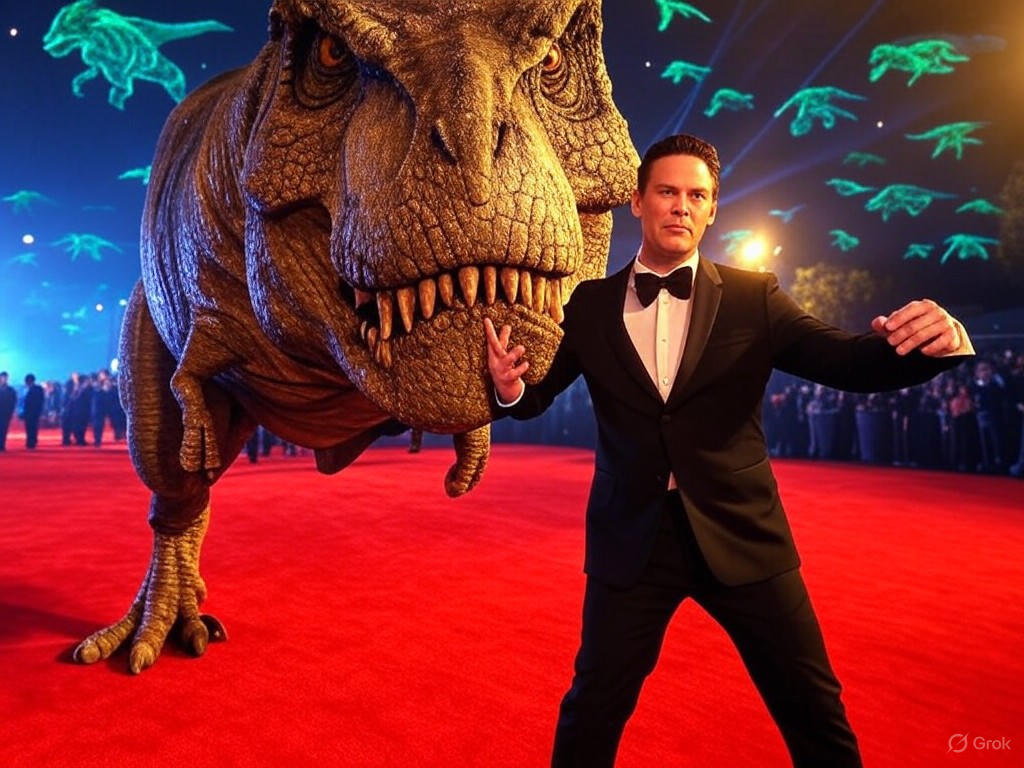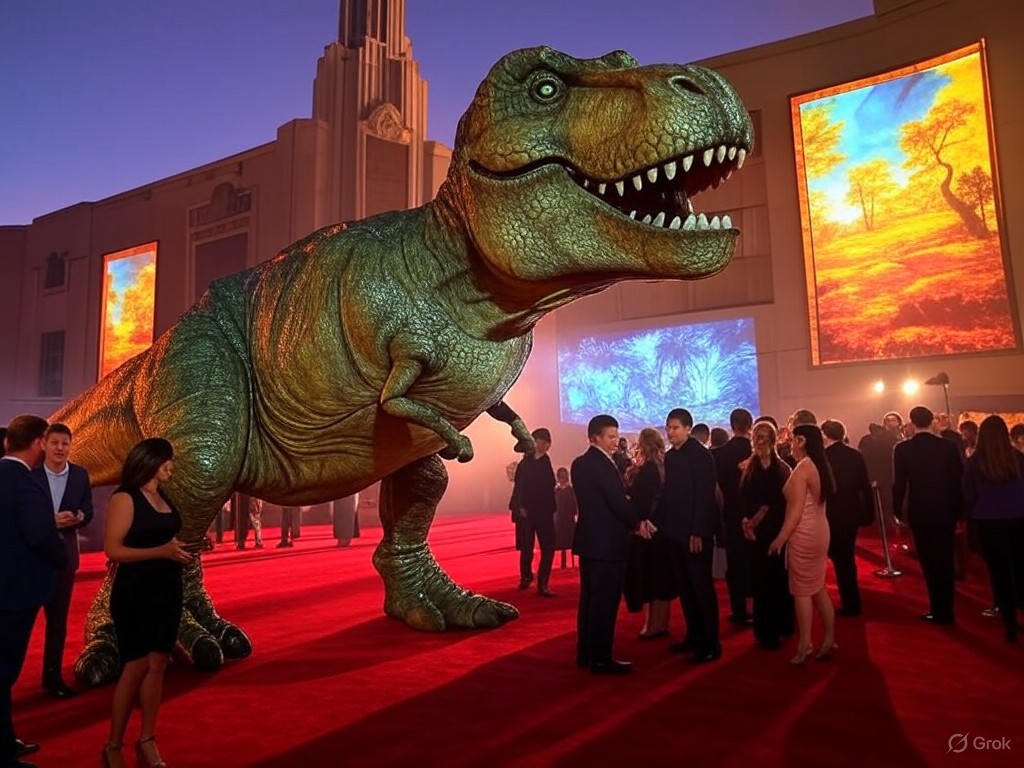Jurassic World Rebirth: Hollywood’s Dino Legacy
In an era where the silver screen often feels like a mirror to our collective past, the premiere of Jurassic World Rebirth serves as a thunderous reminder of Hollywood's enduring fascination with dinosaurs. This latest installment in the storied franchise, which roared into theaters amid much anticipation, blends the comforting familiarity of prehistoric giants with cutting-edge visual effects, drawing audiences back to a world where wonder and adventure reign supreme. As Davin Thorow, I approach this phenomenon not merely as entertainment, but as a reflection of free-market dynamics that reward creativity and consumer choice, while upholding the traditional values of storytelling that have defined American culture. Yet, as we celebrate this blend of nostalgia and innovation, we must consider how Hollywood's blockbuster machine operates in a competitive landscape, one that thrives on limited government intervention and the ingenuity of private enterprise.
Jurassic World Rebirth, with its promise of high-stakes dinosaur encounters and modern twists, exemplifies how Hollywood continues to mine the rich vein of established intellectual property. Premieres like this one, as reported by The Hollywood Reporter, are not just events; they are economic engines that propel the industry forward. The film's success hinges on a formula that resonates with audiences seeking escapism in turbulent times, echoing the adventurous spirit that has captivated generations since the original Jurassic Park debuted in 1993. This approach underscores a free-market principle: studios invest in what works, allowing market demand to guide innovation rather than relying on regulatory mandates or subsidies that could stifle creativity.
The Allure of Dinosaurs in a Free-Market Arena
Hollywood's love affair with dinosaurs is more than mere spectacle; it is a testament to the power of nostalgia as a commercial force. Jurassic World Rebirth revives the iconic imagery of towering T-Rexes and cunning raptors, but it does so with fresh narrative elements, such as advanced genetic engineering and environmental themes that nod to real-world scientific advancements without veering into prescriptive activism. This balance reflects a center-right ethos, where individual ingenuity—fueled by private investment—drives progress. Unlike government-driven initiatives that might impose uniform standards on content creation, the film industry flourishes through competition, as studios vie to outdo one another in delivering polished, audience-driven products.

Crowds gather at the star-studded premiere of Jurassic World Rebirth, capturing the electric buzz of Hollywood's blockbuster revival.
Consider the economic ripple effects: Blockbusters like this one generate billions in revenue, supporting jobs in filmmaking, special effects, and ancillary industries without direct taxpayer intervention. According to The Wall Street Journal, the global box office for franchise films has surged in recent years, with audiences favoring sequels and reboots that offer reliable entertainment. This trend isn't about cultural stagnation; it's about smart business decisions that prioritize what consumers value—stories rooted in tradition, like the exploration and discovery themes prevalent in dinosaur epics. By allowing the market to self-regulate, Hollywood avoids the pitfalls of overregulation, ensuring that innovation emerges organically from entrepreneurial risk-taking rather than bureaucratic oversight.
Analyzing the Evidence: Trends in Blockbusters and Consumer Choice
To understand Jurassic World Rebirth's place in the blockbuster landscape, we must examine the broader data. Hollywood's reliance on established franchises has grown exponentially, with dinosaur-themed films alone grossing over $5 billion worldwide since 1993, as detailed by Box Office Mojo. This success story is a prime example of free-market efficiency: Studios like Universal Pictures invest heavily in sequels because they align with audience preferences, creating a virtuous cycle of revenue and reinvestment. Yet, this model isn't without challenges. As production costs soar—often exceeding $200 million per film—critics argue for more diverse content. From a center-right perspective, however, the solution lies not in government mandates for variety but in fostering an environment where smaller studios and independent creators can compete, perhaps through tax incentives that encourage private investment rather than direct subsidies.
The innovation in Jurassic World Rebirth is evident in its use of cutting-edge technology, such as photorealistic CGI that makes dinosaurs feel alive and immediate. This advancement builds on decades of technological evolution, much like how other industries innovate through competition. Variety highlights how the film's visual effects teams pushed boundaries, blending nostalgia with state-of-the-art techniques to create immersive experiences. Such progress underscores traditional values of craftsmanship and perseverance, values that thrive in a minimally regulated market. Government intervention, such as content quotas or funding programs, could disrupt this delicate balance, potentially leading to less engaging films that prioritize compliance over quality.

Intricate concept art depicting the genetically modified dinosaurs in Jurassic World Rebirth, showcasing Hollywood's blend of scientific innovation and storytelling tradition.
Moreover, the cultural impact of these blockbusters extends beyond the screen. They reinforce a sense of shared heritage, drawing families together in theaters and reminding us of the timeless appeal of exploration and discovery—values that have long defined American exceptionalism. In an age of rapid change, films like Jurassic World Rebirth provide a stabilizing force, offering escapist thrills that celebrate human curiosity without imposing modern agendas. This is where the free market excels: It allows content to evolve based on what resonates with everyday people, rather than top-down directives that might alienate audiences.
The Path Forward: Embracing Market-Driven Storytelling
As we look to the future, the premiere of Jurassic World Rebirth signals both opportunity and caution. Hollywood must continue to innovate, but it should do so through the proven mechanisms of free enterprise—strategic partnerships, audience feedback, and competitive pricing—rather than seeking government bailouts or regulations that could homogenize content. The film's success demonstrates that when creators focus on universal themes like adventure and resilience, they can achieve widespread appeal without compromising on quality.
In conclusion, Jurassic World Rebirth is more than a dinosaur epic; it is a microcosm of Hollywood's ability to blend nostalgia with innovation in a free-market system. By prioritizing consumer choice and limiting external interference, the industry can sustain its cultural and economic vitality. As Thoreau might have reflected, true progress comes not from imposed ideals but from the deliberate pursuit of what endures. Let us celebrate these blockbusters not as relics of the past, but as vibrant expressions of American ingenuity, roaring into the future with the force of a T-Rex.

